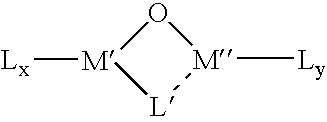Solution polymerization process utilizing preassembled bimetallic Ziegler-Natta catalyst
- Summary
- Abstract
- Description
- Claims
- Application Information
AI Technical Summary
Benefits of technology
Problems solved by technology
Method used
Image
Examples
example 1
[0032] Silica is treated with vanadium oxychloride followed by titanium(IV) isopropoxide in similar manner as described in Chem. Mater. 10 (1998) 620 to afford a preassembled silica-supported bimetallic catalyst with vanadium and titanium linked together by an oxygen atom. The catalyst is expected to have a 1:1 molar ratio of vanadium to titanium and to be about 1.9% by weight vanadium. The proposed structure is:
with the titanium supported on the silica and linked to the vanadium.
[0033] A two-liter, stainless-steel reactor is charged with 1-octene (5.0 g) and dry, oxygen-free Isopar® G solvent (1000 mL) and the reactor is heated to 170° C. The preassembled silica-supported bimetallic catalyst prepared above (0.05 mmol V) is combined with triethylaluminum (0.2 mmol), and the mixture is diluted to 20 mL with Isopar® G solvent. After 5 minutes of mixing, the catalyst mixture is loaded into an injector. The reactor is pressurized with 200 psig of ethylene, and then the catalyst solu...
example 2
[0034] The procedure of U.S. Pat. No. 4,387,199 for making a trimetallic compound is modified to make the desired bimetallic compound. Thus, a solution of vanadium(IV) oxydiacetate (18.5 g, 0.1 mol) in 200 mL of o-xylene is stirred at room temperature and 34 g (0.1 mol) titanium(lV) butoxide is slowly added. The mixture is refluxed for 3 hours and then both butyl acetate and o-xylene are removed by distillation. The expected product is:
[0035] A two-liter, stainless-steel reactor is charged with 1-octene (5.0 g) and dry, oxygen-free Isopar® G solvent (1000 mL) and the reactor is heated to 170° C. The preassembled bimetallic catalyst prepared above (0.05 mmol V) is combined with triethylaluminum (0.2 mmol), and the mixture is diluted to 20 mL with Isopar® G solvent. After 5 minutes of mixing, the catalyst mixture is loaded into an injector. The reactor is pressurized with 200 psig of ethylene, and then the catalyst solution is injected. The polymerization should start immediately, a...
PUM
| Property | Measurement | Unit |
|---|---|---|
| Temperature | aaaaa | aaaaa |
| Temperature | aaaaa | aaaaa |
| Temperature | aaaaa | aaaaa |
Abstract
Description
Claims
Application Information
 Login to View More
Login to View More - R&D
- Intellectual Property
- Life Sciences
- Materials
- Tech Scout
- Unparalleled Data Quality
- Higher Quality Content
- 60% Fewer Hallucinations
Browse by: Latest US Patents, China's latest patents, Technical Efficacy Thesaurus, Application Domain, Technology Topic, Popular Technical Reports.
© 2025 PatSnap. All rights reserved.Legal|Privacy policy|Modern Slavery Act Transparency Statement|Sitemap|About US| Contact US: help@patsnap.com



